Snowflake Data Cloud: Its Benefits and Capabilities
These figures show that data warehouses indeed play a crucial role in enterprise-grade data management, including secure storage and comprehensive analysis. Snowflake’s cloud data warehouse, which comprises 19% of the global market share, is one of the most effective tools in this regard. Read on to discover why.
What Is Snowflake Data Cloud?
Snowflake is a cloud-based data platform that enables companies to store and analyze all their data records in one place, sparing the need to create separate data lakes and data marts. Available as a SaaS, Snowflake is a standalone tool that does not depend on existing big data platforms. It comprises an entirely new ANSI SQL query engine with unique cloud-native architecture that empowers users to rapidly build tables and start querying data without the involvement of a database administrator.
The allure of Snowflake is that on top of all the capabilities of a traditional analytical database, it offers its own unique features. For example, the platform leverages extensibility as a core part of its design, allowing organizations to add new functionality to their warehouse without the need to change the core system.
Snowflake also automatically scales up its compute resources to run a virtually infinite number of workloads — from batch data processing and advanced analytics to creation of complex data pipelines. Your teams can run different queries simultaneously without a hitch. This is possible thanks to Snowflake’s ability to create separate compute clusters that effectively balance loads, thus avoiding poor performance or downtime. At the same time, scaling computing resources is not tied to the storage capacity, which makes Snowflake a cost-efficient and flexible solution.
Snowflake Architecture
Snowflake has a unique architecture that combines the benefits of both shared-disk and shared-nothing architectures. First, Snowlake leverages data simplicity and availability of a shared-disk architecture with a central data repository for persisted data that is accessible from all compute nodes. Second, rock-solid performance and unlimited scalability is guaranteed by using MPP (massively parallel processing) compute clusters where each node stores locally a portion of the entire data set — like with a shared-nothing concept. Such flexibility and efficiency of the platform is enabled by a three-layer architecture, where database storage, query processing, and cloud services can each be scaled independently.
Database Storage
Once you have uploaded structured, semi-structured, or even unstructured data into Snowflake Data Cloud, the platform leverages its optimization and compression capabilities to reorganize that data into a central repository in a columnar format. This layer is used to store data objects and automate their management, handling file size, structure, compression, metadata, and statistics.
The data storage runs independently from compute resources, and the data objects are only accessible through SQL query operations in the Snowflake’s UI or by using programming languages like Java, Python, PHP, Ruby.
Compute Layer
This layer comprises virtual warehouses where all query processing tasks are performed. Snowflake can create as many warehouses as needed depending on the requirements and existing workloads. Each virtual warehouse is an independent compute cluster that enables access to CPU, memory, and temporary storage capacities — to rapidly perform SQL execution and DML (data manipulation language) operations.
Since each warehouse can access any data in the storage layer and process it independently without competing for resources, Snowflake enables nondisruptive scaling. This means compute resources can scale automatically without the necessity to rebalance or redistribute data at the storage layer. To further increase performance, Snowflake analyzes the queries, uses the latest micro-partitions, and gauges caching at different stages.
Cloud Services
This layer leverages ANSI SQL to coordinate all activities across Snowflake. Being highly scalable, the cloud services support thousands of customer accounts and smoothly manage millions of queries daily, including user requests, metadata, client sessions, transactions, query planning, security, and governance. All this is managed in an automated manner, and there is no need for manual data warehouse management and tuning. The services include:
- Authentication. Snowflake provides a variety of authentication methods, including password- and key-based authentication, single sign-on, OAuth, and more.
- Access control in Snowflake combines the RBAC and Discretionary access control (DAC) models, meaning each data object has its owner who controls the access, and access privileges are assigned to roles and users.
- Infrastructure management enables automatic spin ups and downs for a virtually infinite number of workloads processed in parallel.
- Metadata management. Snowflake automatically generates metadata that includes File Names, Version IDs, and Associated Properties — to function as a directory, define warehouse objects, and locate data warehouse content.
- Query parsing and optimization. This layer parses and compiles the query, identifying the location of the data of interest and flagging it for scanning. Before being sent to processing, the query passes through the layer’s optimizer.
This three-layer approach to architecture, along with some unique and innovative features, makes Snowflake a top tier choice for enterprise data management. Let’s explore in detail the advantages of the platform.
Snowflake Benefits and Capabilities
Near-Zero Administration
As opposed to traditional data platforms, Snowflake does not have significant management constraints. The platform is designed to offer high performance without the need for administration overhead. Snowflake analyzes the workload demand and automatically scales the database. The platform also has automated performance tuning, infrastructure management, and optimization capabilities, making human intervention in the management process redundant.
Availability
Snowflake provides 99.9% or greater availability, which makes it an enterprise-grade platform suitable for business-critical data storage solutions.
Such increased resiliency to server and hardware failures is possible thanks to the Snowflake’s three-layered architecture that ensures successful query completion despite server or hardware failures. The platform has multiple warehouses performing in different availability zones, so if a single compute instance fails, Snowflake continues tasks execution in another instance without disruption. Moreover, once one of the zones becomes unavailable, the cloud services layer can reprovision the impacted warehouse in another zone, restarting query execution.
Workload Separation
Among other benefits of Snowflake is its ability to eliminate concurrency issues. The platform’s multi-cluster architecture enables the separation of workloads, i.e., disparate tasks are executed in different virtual warehouses. As a result, users can run ETL/ELT processing, data analysis, and reporting without competing for resources like in traditional cloud platforms.
Semi-Structured Data Management
Semi-structured data that typically goes in JSON format is not so easy to handle. In order to parse JSON, you have to build specific data pipelines that would smoothly extract attributes and combine those attributes with structured data.
Snowflake’s architecture eliminates the need for special data extraction pipelines. Its custom schema on reading data type, named VARIANT, helps immediately parse both structured and semi-structured data, extract its attributes, create hierarchies, and store them in the same destination in the needed columnar format.
Multi-Cloud Support
The overwhelming 95% of organizations understand that multi-cloud architectures are critical to business success. However, 70% of them struggle with multi-cloud complexity.
Snowflake is the only fully managed data warehouse that operates in multiple clouds with equally great user experience. It supports all major cloud vendors — Amazon Web Services, Google Cloud Platform, and Microsoft Azure.
Seamless Data Ingestion
Time efficiency, data complexity, changing ETL schedules, duplicated data, compliance — these are some of the most widespread challenges revolving around data ingestion. Snowflake has its own tailored service called Snowpipe that makes ingestion a piece of cake. This tool is cloud-based, so there are no worries about infrastructure management or capacity planning.
Snowpipe continuously loads data into your warehouse in micro-batch chunks, making it available to users within a minute. As Snowflake is able to isolate warehouses and adjust their size, the process of ingesting multiple tables in parallel and performing ETL operations like transformations and validations is fast and efficient.
Streamlined Data Sharing
With Snowflake’s Secure Data Sharing, you can solve the challenge of moving ever-increasing volumes of data among internal and third-party users, while ensuring security, data governance, and high data quality. Data can be shared among multiple consumers, and consumers can access the data from multiple providers.
One of the options is sharing data through Snowflake listings. Such an automated method allows you to not only send data to any region and across clouds, but also provide additional metadata and understanding of how customers use the data. You can enable a private listing for specific accounts or make data public on the Snowflake Marketplace. A direct share is another method of sending data sets, but it has its limitations. For example, you are restricted to one account per particular region to share the data and cannot use data auto fulfilling across multiple clouds.
No matter the method of data sharing you choose, you will be able to share data with users who do not have Snowflake accounts. This is possible through Snowflake’s reader accounts. All the shares are secure, configurable, and controlled by the provider, who can immediately revoke access if needed.
Robust Security
As stated in a recent report, targeted attacks on cloud infrastructure in 2022 doubled compared to 2020. For 7% of respondents these attacks led to financial damages of more than $500,000 for each of their respective companies.
Snowflake offers a wide range of security features to make sure the data is injected, stored, analyzed, and shared in the safest manner. Some of them include:
- Whitelisting, which allows restricting access to your account by approving a certain list of IP addresses, domain names, and applications, while denying others.
- Multiple authentication methods, including two-factor authentication and support for SSO through federated authentication.
- The hybrid RBAC and DAC model, which controls the privileges assigned to roles and users as well as who can grant access to sensitive objects and how they do so.
- End-to-end encryption: All data — in transit and at rest — is encrypted using AES 256.
Where To Go from Here: Snowflake Implementation
To integrate cutting-edge Snowflake technology into your business processes without disruption, rely on assistance from an experienced cloud provider like Infopulse. We will help you with сloud infrastructure analysis; managed cloud services, including AWS implementation and Microsoft Azure assistance; and data warehouse services such as design, development, and customization.
![Snowflake Data Cloud Overview [banner]](https://www.infopulse.com/uploads/media/banner-1920x528-sowflake-data-cloud-its-benefits-and-capabilitie.webp)
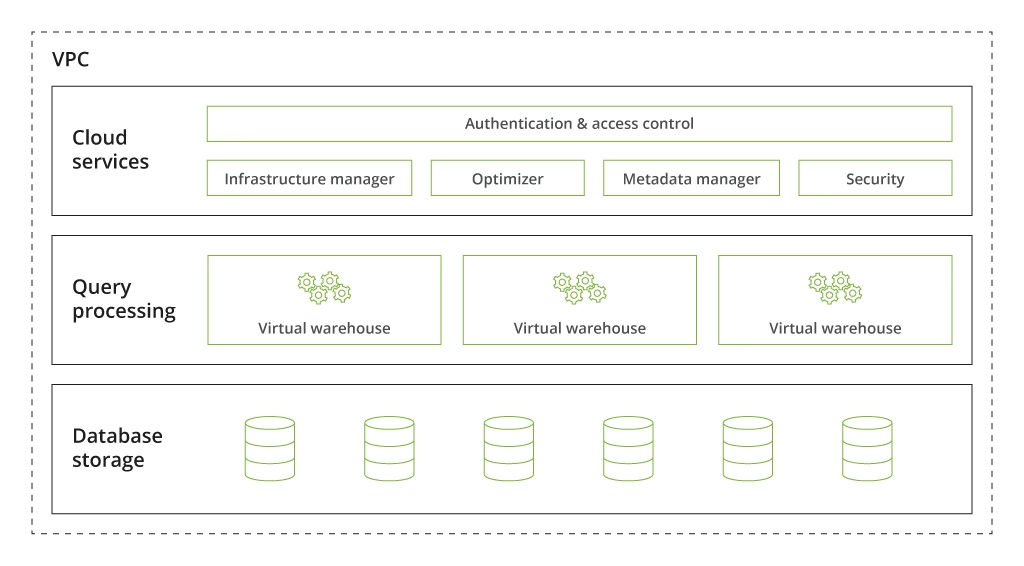
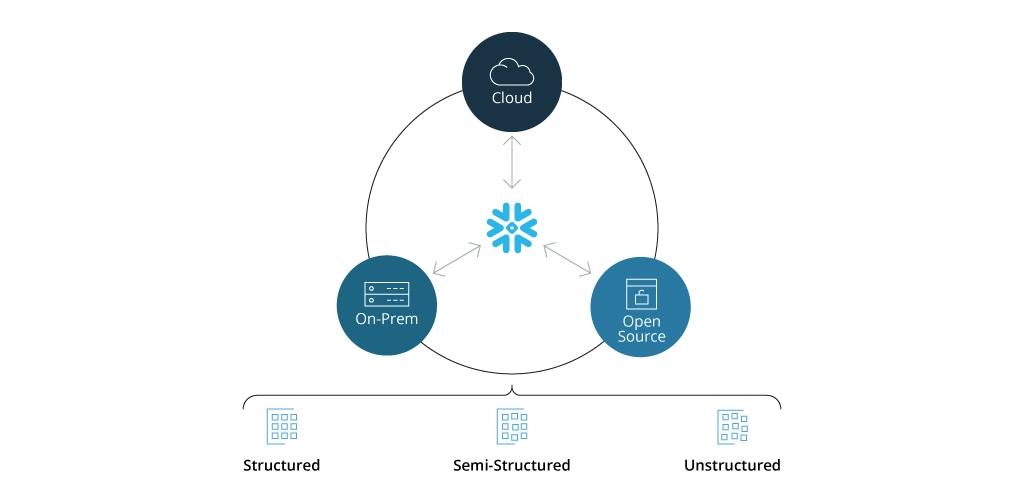

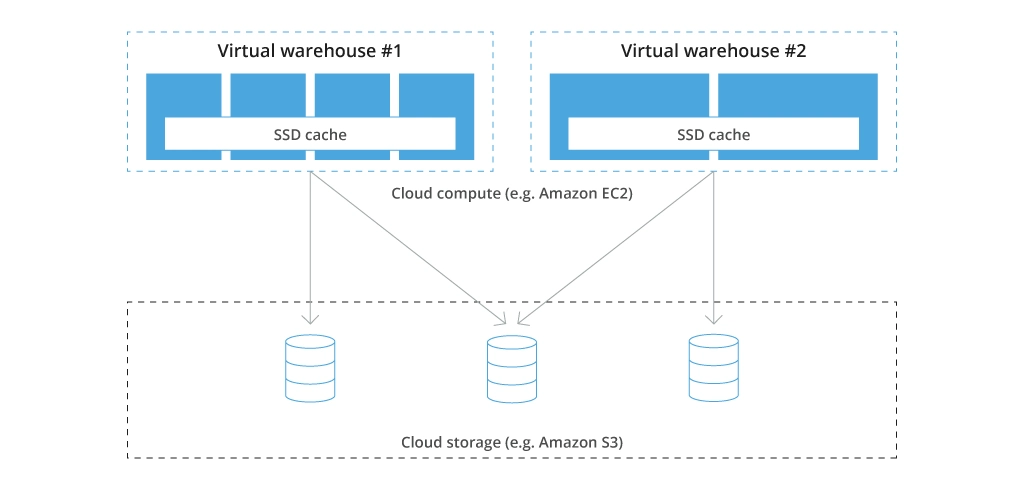


![Generative AI and Power BI [thumbnail]](/uploads/media/thumbnail-280x222-generative-AI-and-Power-BI-a-powerful.webp)
![Data Governance in Healthcare [thumbnail]](/uploads/media/blog-post-data-governance-in-healthcare_280x222.webp)
![AI for Risk Assessment in Insurance [thumbnail]](/uploads/media/aI-enabled-risk-assessment_280x222.webp)
![IoT Energy Management Solutions [thumbnail]](/uploads/media/thumbnail-280x222-iot-energy-management-benefits-use-сases-and-сhallenges.webp)

![Carbon Management Challenges and Solutions [thumbnail]](/uploads/media/thumbnail-280x222-carbon-management-3-challenges-and-solutions-to-prepare-for-a-sustainable-future.webp)

![Automated Machine Data Collection for Manufacturing [Thumbnail]](/uploads/media/thumbnail-280x222-how-to-set-up-automated-machine-data-collection-for-manufacturing.webp)

